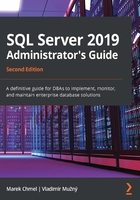
Summary
The SQL Server ecosystem provides you with a wide set of technologies. The first problem is to know what is the responsibility of every single technology of SQL Server. In the first section of this chapter, we cleared what is necessary to install, which helped us recognize what we need.
In the second section, we prepared our operating system and the complete infrastructure to install SQL Server. The most important decision before starting the installation is which technologies to install and how many computers will be needed to distribute SQL Server services appropriately across an infrastructure. Before installing SQL Server DE itself, we need to ensure that a sufficient set of disk storage is in place, appropriate security accounts are prepared, and all software prerequisites are fulfilled.
The installation described in the Installing SQL Server 2019 on Windows section of this chapter is quite a straightforward process, but we should still consider some settings. Even if many of the settings can be adjusted after the installation completes, the SQL Server installation wizard helps us with the correct setting. In this section, we also highlighted settings (namely, Collation) that cannot be changed after the installation of the SQL Server.
After installation, it's highly recommended to check whether SQL Server is running, and, if not, check logs in the Setup Bootstrap folder. When SQL Server is successfully running, we need to check SQL Server's accessibility locally and remotely.
Last but not least is a check of the SQL Server Agent state because, for administrators, this service is an invaluable helper when performing day-to-day administrative tasks. SQL Server Agent should have the startup mode set to automatic and should be running all the time SQL Server DE is.
It is very useful to do more configuration after installation. The next chapter talks about these configuration settings and discusses more on how to keep SQL Server healthy.